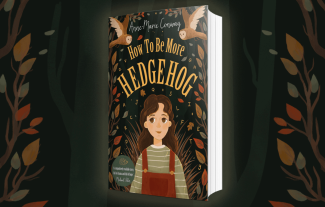Book review: How to be more hedgehog

A new book for children by Anne-Marie Conway gives a contemporary look at the pressures faced at school when you stammer. Katherine Brown, a parent from our volunteer book review team, gives her review.
How to be More Hedgehog is a book written from the perspective of Lily, a girl in year 6 of primary school, who returns to a busy term after the Christmas break. Lily has a lot to juggle — schoolwork, friend dynamics, a new teacher, a blended family, a busy mother and an angry brother. But by far her biggest challenge, and the one that disrupts her life the most, is her stammer.
Through the story, the book provides a detailed account of what life is like for Lily; it explains how her stammer manifests and how it impacts her everyday life and schooling on many different levels. The book also explores how Lily's family and friends react to her stammer, and how she feels about this.
The charming hedgehog metaphor is woven carefully into the story, encouraging readers to find their inner strength and outer armour.
Some serious topics are touched upon in the book, including bullying, peer pressure, social media trolling, feelings of isolation, anxiety and other mental health issues. But, despite the hardship, it also gives a little humour, as well as a steadfast hope throughout in the form of Lily's strength of heart. She has a strong attachment to her favourite teddy, and as the story unfolds, we learn how she finds courage from her true friends and her dedication to nature. The special bond she has with her father, and her love for his (and her) new family also boost her morale until she is finally able to stand up for herself and accept her stammer.
How to be More Hedgehog is a story of self-belief and finding the strength to live with difficulties. The charming hedgehog metaphor is woven carefully into the story, encouraging readers to find their inner strength and outer armour. It is a very readable book with some important information to share, and would be suitable for children in years 5 and 6 of primary school, up to secondary school age. But this book has a wider audience too — the explicit and honest descriptions of Lily's stammer and what she is thinking, e.g:
"...my face tenses with concentration and my eyelids flicker like a trapped butterfly. Now I get why… people mimic me, interrupt me, finish my sentences and laugh behind my back"
give the book an authenticity that means it could lend itself to being a supportive text for a child with a stammer, a resource for adults looking to gain an insight into how it may feel to stammer and why life can be challenging, or even a reference for anyone wanting to learn how to be a little more hedgehog.
As a final note, it should be mentioned that Lily's experiences lean the story more towards the medical model of disability; however, there is a shift towards the social model of disability as the book progresses. (Ed: read more about the medical and social models.)
How to be More Hedgehog by Anne-Marie Conway is published by UCLan Publishing and is available to buy now.

































